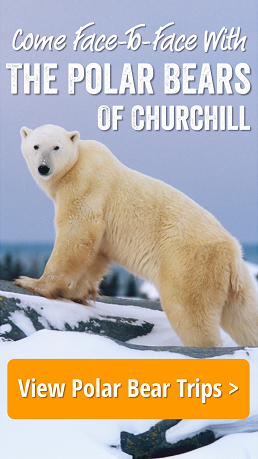by Steve Selden | Sep 24, 2012 | Churchill Photography, Tour News
In Churchill every season is polar bear season. True “Churchillians”..er, that is “locals”…never stop thinking about polar bears. It would be truly unwise to do so. A constant guard has to be maintained living in this frontier town. Other than the heart of winter, one has to be alert to surroundings 24/7. For all others, October and November signify a gathering, not just of bears, but of people. Travelers also migrate to the north..Churchill…to become a part of this amazing phenomena known as “polar bear season”.
In about two weeks Churchill will begin to feel the stir of this year’s polar bear season. The town will transition from the lull between Summer and the frenetic pace of the busiest time of the year. For this town of about 900 residents, the world will be watching. Thousands will converge upon this tiny town on the shores of the Hudson Bay and the one main street running through the heart of town..Kelsey Boulevard. The town will become an incredible melting pot of people and wildlife for two months and then stillness.
Here are some of my favorite, classic images from recent years in Churchill!

Polar bear sniffing the air. Brad Josephs photo.
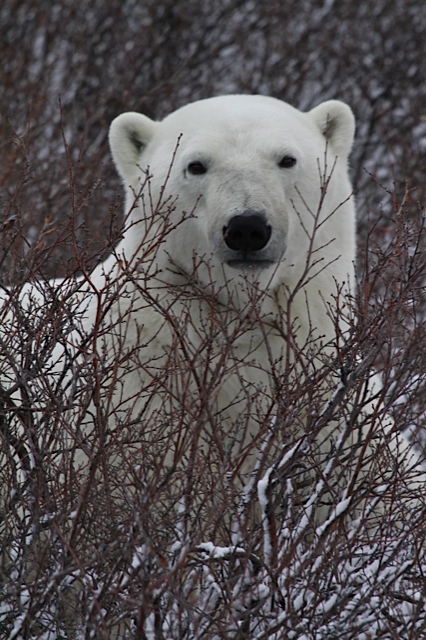
Polar bear resting in willows.

Curious polar bear detects scent.
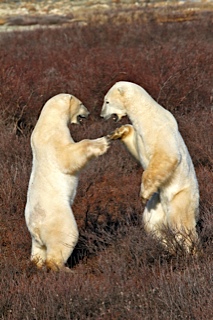
Two polar bears prepare to spar.

Polar bear resting on a rock. Brad Josephs photo.
by Steve Selden | Sep 10, 2012 | Churchill News
The Manitoba Conservation department has found encouraging signs that the Southern Hudson bay polar bear population may be in better shape than some skeptics think….. a prodigious number of polar bear dens situated along the Hudson Bay coast near the Ontario boundary.
The dens were located in the southeast of Wapusk National Parc and east of the Nelson River. This area lies at the southern end of the polar bear’s range and is less famous as Wapusk National Parc which is adjacent to the Churchill region. Wapusk has long been known as the number one polar bear denning site in the area and in fact most of Canada. I have had the unique pleasure of crawling inside a den that had been vacant for a number of years. Quite a thrill!
“We’ve always known that there are dens in there … but not to this extent,” said Daryll Hedman, the regional wildlife manager for northeast Manitoba.
“We have a fairly large number of denning females in there, equal to or even maybe surpassing Wapusk National Park, so it’s fairly exciting news.”
Female polar bears dig the dens in the ground to give birth. The discovery could be a sign that the polar bear population in the area is in good shape, at least for now. The province is beginning a three-year study to get more detail.
 Darryl Hedman, a regional wildlife manager with Manitoba Conservation, examines a polar bear den in Manitoba’s Wapusk National Park in this 2011 handout. (The Canadian Press)
Darryl Hedman, a regional wildlife manager with Manitoba Conservation, examines a polar bear den in Manitoba’s Wapusk National Park in this 2011 handout. (The Canadian Press)
The Hudson Bay polar bear population is threatened by a shrinking number of ice coverage days leading to less time feeding and building up fat reserves for Summer on land. The amount of ice coverage days has been cut down by a period of up to two weeks going back over the last two decades. Bears still seem to be surviving and even possibly adapting to the lack of ice with new hunting techniques. Over the last two years, in the time leading up to and even during Churchill’s prime polar bear season in October and November bears have been observed with fresh seal kills on land in the shallows where seals tend to get trapped by the tide at times. Resourcefulness is the key to survival in the Arctic.
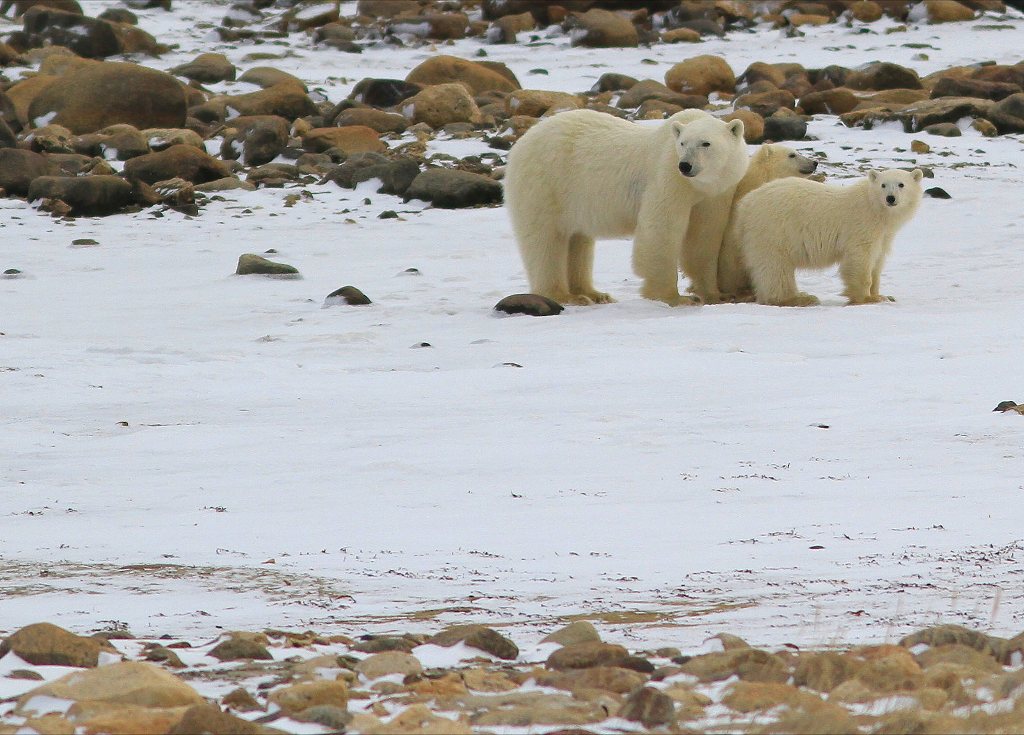
Brad josephs photo.
The lack of food makes the females job of giving birth that much harder. They spend even less time on the ice then the males due to their time in the dens. They have to rely heavily on fat reserves to get them through the Winter.
Climate change is also affecting the permafrost the bears use for their dens. Dens do not collapse under permanently frozen ground, but scientists are worried warming temperatures will cause the permafrost to recede northward. This might limit the territory needed to have a healthy denning environment as polar bears are quite territorial.
Not everyone agrees that polar bears are in trouble. The Nunavut government released a survey earlier this year that said Canada’s Hudson Bay polar bear population hasn’t significantly declined in the last seven years as predicted. An aerial survey estimated the western Hudson Bay bear population at around 1,000…roughly equivalent to the number of bears found in a more detailed study done in 2004. That study, which physically tagged the bears, predicted the number would decline to about 650 by 2011. Somehow, despite the increase in ice-free days, the polar bears are seemingly keeping a stable population in the Churchill region.
by Steve Selden | Sep 5, 2012 | Churchill Photography
Check out this image of two bears in the Hudson Bay. Now that’s the authentic polar bear dip. Although not common to capture photo’s of polar bears in the water around Churchill, every once in awhile you can be at the right place at the right time. When the ice starts to melt in the Spring, bears can swim miles to land and a resting area. It is a magnificent feeling to watch a bear slowly move through the water and come ashore. Hard not to get the chills when observing these creatures in 42 degree F water!

Tasha Esau photo.
by Steve Selden | Aug 24, 2012 | Churchill News, Churchill Photography, Tour News
As the Summer winds down in Churchill, the beluga whale population gives us amazing shots to capture on film…er camera..chips? Not sure how you say that anymore. Anyway some of these classic photo’s remind us how amazing it is out on the water of the Churchill River or Hudson Bay. With polar bears lurking along the shores of Eskimo point and Cape Merry, the Arctic feel is all around. Birds grace the air over the water looking for capelin stirred up by the whales. All in all one feels “in” nature…amazing.

Beluga looking up. Photo Katie Demeulles.

Beluga in the Churchill River. Rhonda Reid photo.

Tundra swans on shallow lake. Ed Bouvier photo.
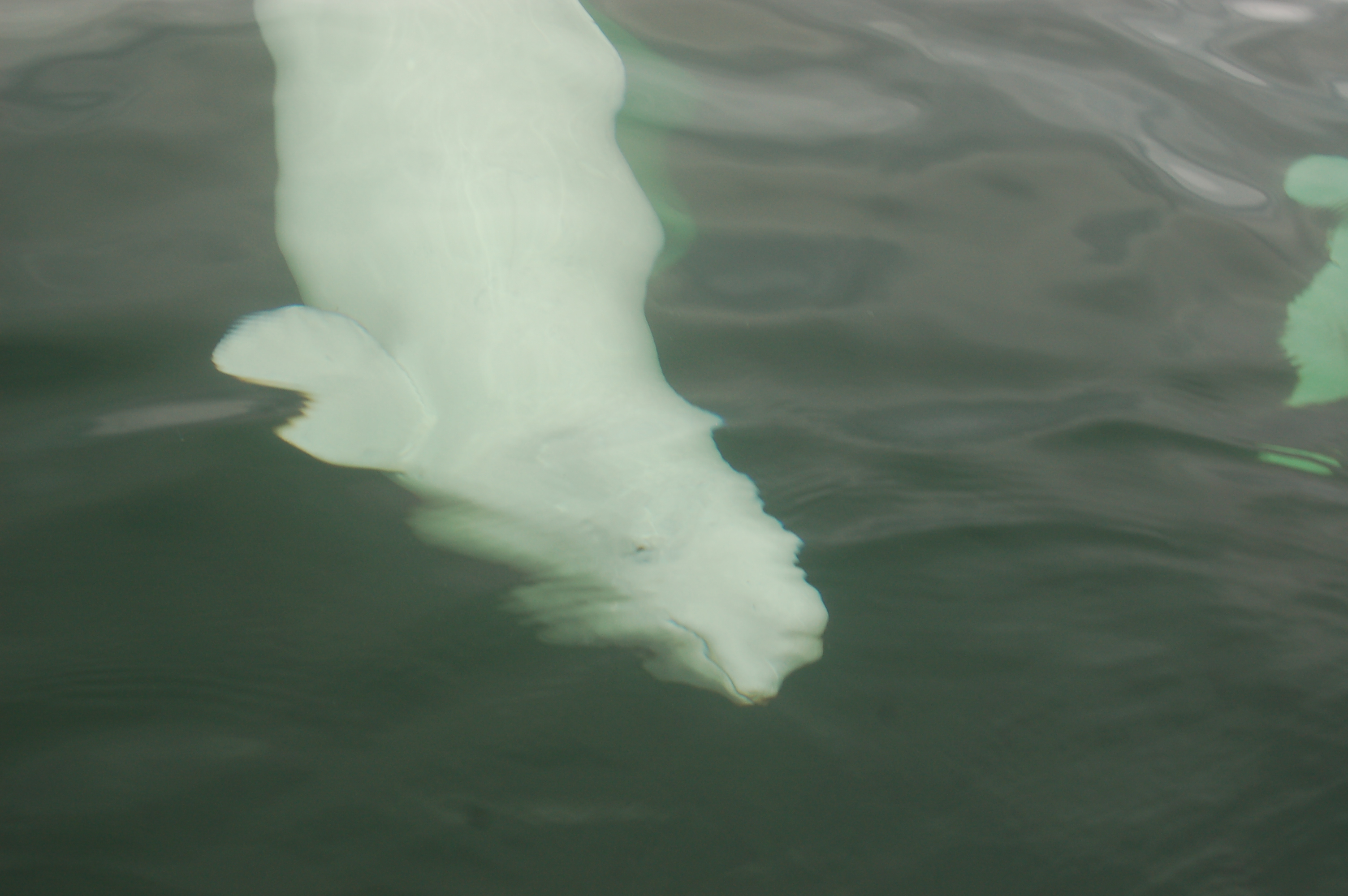
Beluga whale in Churchill River, Churchill,MB. Steve Selden photo.
- Trolling for beluga whales in the Churchill River.

by Steve Selden | Aug 19, 2012 | Tour News
The final Natural Habitat Summer group of the year started off with some nice weather for getting in the cold water of the Churchill River. A few in the group donned neoprene dry -suits, booties and gloves and snorkeled with beluga whales. This is an unforgettable experience ….more due to the frigid water in the low40 degree temp range than whale encounters. Whales become curious and swim below snorkelers at times though often keeping a safe distance. Still, being in the water so close to these amazing beings can ma one forget about the cold pretty quickly.
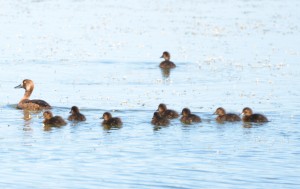
Young ducklings with mom in the local ponds. Photo Rhonda Reid
Later, as the group traveled around Churchill, various bird-life revealed itself all around town. Eider ducks and their young floated above beluga whales just offshore behind the town complex. Whimbrels, Hudsonian godwits and assorted ducks were flocking up for the long trip north and some geese are already in the air having been cleared by air traffic control for the migration. Cape Merry provided a Parcs Canada interpretive talk with Duane overlooking the river and Hudson Bay. No better spot to feel the vastness of the Arctic than the cape.
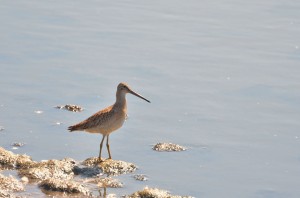
Lesser Yellowlegs near the Churchill shore. Rhonda Reid photo.
With a full day behind, some went for a walk around the loop of the flats next to the river and some went birding at the ponds just before the grainery and had some fantastic sightings.. Red-necked phalaropes were the biggest hit for the birders as they spotted adults and juveniles. Ruddy turnstones, lesser yellowlegs, lesser scaups, some with up to 10 two or three- day old young , American widgeon with two-week old young, Arctic terns with young just ready to fledge, a herring gull encouraging its’ three chicks to fly, a Wilson’s warbler, an adult pair of Bonaparte gulls, a semi-palmated sandpiper, a least sandpiper, and a green-winged teal with ducklings. Many of these birds were life species for almost everyone there. An incredible extravaganza of birds all in roughly an hour.
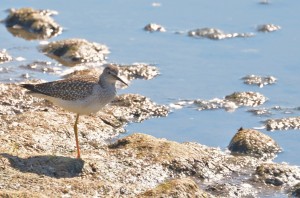
Lesser yellowlegs. Rhonda Reid photo.
Near the end of the trip the travelers experienced a polar bear extravaganza. Eskimo point provided a raw sighting of a polar bear just out of the bay while the group trolled the water in zodiacs in search of beluga whales. Nice bonus. Another bear was seen on land as a vehicle was positioned just at the right angle to get a great look at a stunning animal. All were happy to get the looks usually reserved for bear season in November.
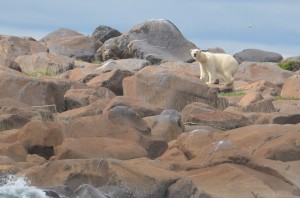
Polar Bear on Eskimo point. Rhonda Reid photo.
As the Summer comes to a reluctant close, the aurora shines bright in the night sky. Reports of brilliant lights have been coming in over the past couple of days. This time of year can rival deep Winter for the best times to view the Northern lights. Clear skies and few storms provide awesome nightly activity. Of course one needs to stay up a little later, around 11 pm or so, to get the best looks at the phenomena. It’s definitely worth the late night.






 Darryl Hedman, a regional wildlife manager with Manitoba Conservation, examines a polar bear den in Manitoba’s Wapusk National Park in this 2011 handout. (The Canadian Press)
Darryl Hedman, a regional wildlife manager with Manitoba Conservation, examines a polar bear den in Manitoba’s Wapusk National Park in this 2011 handout. (The Canadian Press)










